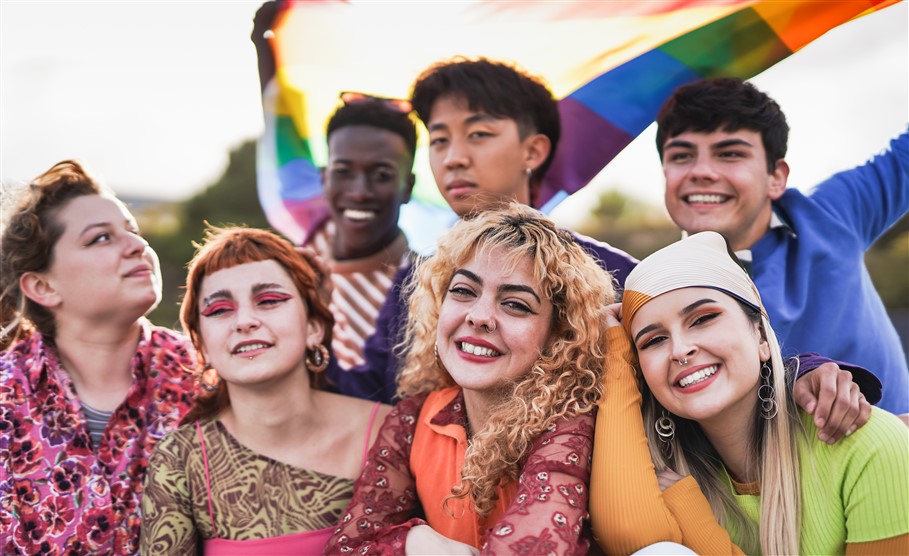Supporting LGBTQ Youth in Schools: A Critical Step Toward Suicide Prevention
Lesbian, gay, bisexual, transgender, queer, and questioning (LGBTQ) youth are at a significantly higher risk for suicide compared to their straight and cisgender peers. This disparity is not due to their identities but rather the discrimination, rejection, and marginalization they often face—particularly in school settings.
Schools play an influential role in the lives of LGBTQ youth. For many, they are spaces that can either affirm their identity or compound feelings of fear and isolation. Each new school year, LGBTQ students must navigate environments that may or may not be safe and supportive.
According to the most recent National Survey on LGBTQ Youth Mental Health:
- 59% of LGBTQ middle and high school students felt unsafe at school because of their sexual orientation,
- 42% because of their gender expression,
- 37% because of their gender identity.
However, the data also show hope: LGBTQ youth who attend schools with affirming and inclusive environments have nearly 40% lower odds of attempting suicide compared to those in unsupportive settings.
To foster safety and well-being, schools must:
- Integrate positive, accurate content about LGBTQ people and issues into classroom lessons and school libraries.
- Acknowledge and respect students' sexual and gender identities, reinforcing a sense of belonging.
- Provide comprehensive suicide prevention training for everyone in the school community—not just teachers and administrators, but also support staff, bus drivers, and cafeteria workers. Include students and parents in annual training plans.
Importantly, most youth, including LGBTQ youth, turn to friends when they are struggling. Equipping students with the tools to recognize signs of distress and respond with empathy can save lives. Suicide prevention training empowers young people to support each other and strengthens their resilience.
Every student deserves to feel safe, seen, and supported. Creating inclusive schools is not just good practice—it's lifesaving.
LGBTQ mental health and suicide prevention education
The American Foundation for Suicide Prevention (AFSP) has long been at the forefront of suicide prevention through education, research, and advocacy.
Talk Saves Lives: An Introduction to Suicide Prevention in the LGBTQ+ Community is an education program that gives participants essential and lifesaving understanding of topics including:
- Suicide risk and its unique considerations in LGBTQ+ communities
- Recognizing suicide risk factors and warning signs for LGBTQ+ people
- Protective factors that can help lower the suicide rate
- The latest research related to LGBTQ+ suicide prevention
- How to seek and offer support for yourself or others
- Crisis resources and services for the LGBTQ+ community
- What communities can do to support LGBTQ+ people
We all have a role to play in preventing suicide, and those in the LGBTQ+ community may face additional challenges and barriers to help because of discriminatory factors. This new program informs more people of the best ways to provide care and support to those who need it.
Find Talk Saves Lives events by visiting the AFSP Program Calendar.
Mental Health Resources in the LGBTQ+ Community
Transgender Community

Trans Lifeline:
This free and confidential lifeline is available by phone and offers direct emotional and financial support by and for members of the Trans+ community across the United States.
To access this lifeline, call 877-565-8860.
The Trans Lifeline also maintains a directory of hotlines and warmlines that provide a range of specialized services, including BIPOC-specific crisis lines, LGBTQ+ & religious crisis lines, substance abuse (crisis) support, mental health crisis support, and more. Additional information, gender-affirming resources, and more can be found on their website.
LGBTQ+ & BIPOC (Black, Indigenous, and People of Color) Communities
BlackLine:
This hotline is available 24/7 via call and mobile app and provides peer support, crisis support, and an avenue to report vigilante and police misconduct. BlackLine is operated by and primarily for members of the BIPOC and LGBTQ+ communities.
To access this resource, call or text 1-800-604-5841. Users can also download the BlackLine app on their mobile devices. For more information and FAQs, please visit their website.
DeQH Helpline:
The Desi LGBTQ+ Helpline for South Asians is a free and confidential resource that provides peer support to individuals identifying as LGBTQ+ and South Asian. The helpline can be reached between 8-10 pm Eastern on Thursdays and Sundays.
To access this resource, call 908-367-3374. Callers can also leave a message and request a call back if attempting to reach the hotline outside operating hours. Additional information and resources, including local support groups, can be found on their website.
INARA Warmline:
This free and confidential warmline is operated by members of the Muslim Alliance for Sexual and Gender Diversity to support, empower, and connect LGBTQ+ Muslims. The warmline is available from 5-11 pm Central on Fridays and Saturdays.
To access this resource, call 71-QTM-INARA (717-864-6272). Visit the MASGD's website to access their online programming, additional resources, and more information about the organization.
LGBT National Hotline:
This free and confidential resource is available by phone from 4 pm-12 am Eastern Monday-Friday and 12-5 pm Eastern on Saturdays. Trained volunteers are available to support members of the LGBTQ+ community and provide a safe and affirming space to talk during operational hours.
To access this resource, call 888-843-4564. More information, programs, and hotlines can be found on their website.
What You Can Do to Help
Suicide is preventable, and supportive adults play critical roles in the lives of young people at risk for suicide. Learn the risk factors and warning signs of suicide, along with the specific protective factors that keep young LGBTQ people safe.
Resources for Parents and Caregivers
It is important to tell your child you are concerned and want to help, regardless of their sexual orientation or gender identity. Some organizations that offer information and guidance around suicide prevention and supporting LGBTQ youth include:
- Youth suicide warning signs
- The Trevor Project: Crisis intervention and suicide prevention support for LGBTQ youth and their loved ones
- TransYouth Family Allies: Guidance and support for transgender youth, their families and communities
- The Jed Foundation: Suicide prevention strategies in college and university environments
- Not sure what to do? Call 988 for immediate, free, and confidential support.
NOTE: These two programs are specific to New York City. Similar support programs may be available in your community.
- PFLAG NYC: Peer-to-peer support for parents, families and friends of LGBTQ people.
- The Center: Local, comprehensive community center for NYC LGBTQ youth and their families. Visit in person or online.
Resources for Schools
- Look for training available in your area. Youth Mental Health First Aid and Kognito At-Risk are good choices.
- The Jed Foundation: Prevent suicide on college and university campuses
- GLSEN: Create a safe and inclusive environment for LGBTQ youth and their allies
- Download the #BeThe1To Message Toolkit for 5 steps to help someone in crisis
- How Do Mental Health Conditions Affect the LGBTQ Community? (NAMI)
If you are thinking about suicide, reach out to someone you trust, your doctor, or call 988 for free, confidential, and immediate support.
Crisis intervention resources for LGBTQ youth and their caregivers include:
- The Trevor Project's 24/7/365 suicide prevention and crisis intervention hotline for LGBTQ youth and their loved ones: 1-866-488-7386
- Support via text (Crisis Text Line): Text "START" to 741-741
- National Suicide Prevention Lifeline: 1-800-273-TALK (8255)
 A
Culture of Caring: A Suicide Prevention Guide for Schools (K-12) was
created as a resource for educators who want to know how to get started and
what steps to take to create a suicide prevention plan that will work for their
schools and districts. It is written from my perspective as a school principal
and survivor of suicide loss, not an expert in psychology or counseling. I hope
that any teacher, school counselor, psychologist, principal, or district
administrator can pick up this book, flip to a chapter, and easily find helpful
answers to the questions they are likely to have about what schools can do to
prevent suicide.
A
Culture of Caring: A Suicide Prevention Guide for Schools (K-12) was
created as a resource for educators who want to know how to get started and
what steps to take to create a suicide prevention plan that will work for their
schools and districts. It is written from my perspective as a school principal
and survivor of suicide loss, not an expert in psychology or counseling. I hope
that any teacher, school counselor, psychologist, principal, or district
administrator can pick up this book, flip to a chapter, and easily find helpful
answers to the questions they are likely to have about what schools can do to
prevent suicide.


